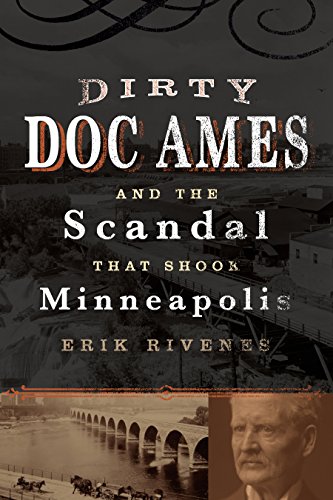Book Review: Dirty Doc Ames and the Scandal That Shook Minneapolis by Erik Rivenes
City government corruption is a recurring problem in American politics. Some cities are notorious for their local corruption levels, while others have it come and go. Minnesota cities are no exception, though it has seldom reached the level of Mayor Albert Alonzo “Doc” Ames’ fourth term in 1901.

The son of one of Minneapolis’ founding fathers, and a prominent citizen, Dr. Ames (yes, he was a medical doctor) was elected mayor three times as a Democrat. And during those terms, there was the expected amount of corruption, with Doc hanging out with saloonkeepers and brothel proprietors in a manner too friendly for some to swallow. Plus, his family life and drinking habits had become scandalous. By the late 1890s, the Democratic Party leadership in Minneapolis had tired of Doc and no longer supported him.
Dr. Ames still wanted to be mayor, though, and used the “open primary” system to switch parties and run as a Republican. His “wide open city” policies were still very popular with a large section of the voting public, and adding those to the die-hard partisans who would vote for anyone with an “R” after their name on the ballot, he won his fourth term.
The big advantage of being mayor of Minneapolis at the time was direct control of the police department, and Mayor Ames decided that this time he was going to take full advantage of it as a money-making machine. He appointed his brother Colonel Fred W. Ames (Spanish-American War hero, or coward, depending who you believed) police chief, fired many honest officers, and hired new officers and detectives based on their willingness to pay fees and pledge loyalty to the new regime.
Minneapolis’ vice dens were squeezed for payoffs, especially independent brothels, and crooked card games fleeced tourists with the largest cut going directly to the police. The loot was rolling in, but of course it was unsustainable. The papers broke the scandal, there were arrests and trials, and eventually even Doc Ames himself was on trial for corruption, with a shocking conclusion.
This volume covers many of the details involved in the affair and the colorful personalities involved. The writing is okay, allowing the subject matter to carry interest. There are black and white illustrations, a copious amount of end notes, and an index.
One admitted weakness of the book is that none of the people involved were the type to keep personal journals or collections of their correspondence, so these valuable insights are largely unavailable and the author had to rely on the notoriously biased newspapers of the day for much of the book’s information.
This volume will be of most interest to those with an interest in Minneapolis history, but anyone who loves reading about political scandals should be able to enjoy it. Consider buying it directly from the Minnesota Historical Society so they can fund more exciting books!

